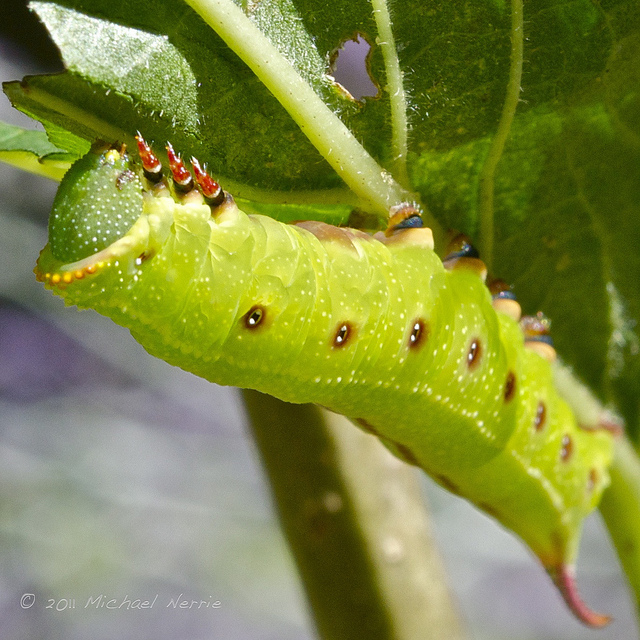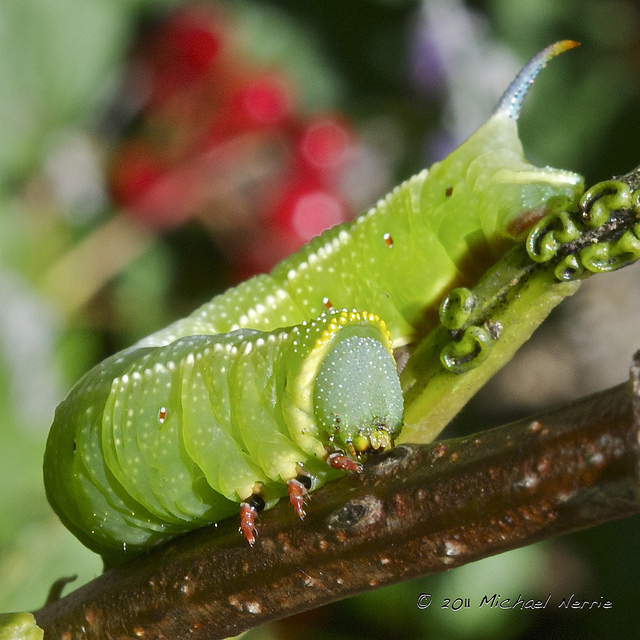Reproduction / Life Cycle
Many populations of moths are dependent on several climate and
biotic factors in the environment for success of growing and
maturation of offspring. Proper placement of eggs is important for
incubation time as well as protection for the growing young. Other
important factors include a sufficient food source for the larvae
once they have hatched and protection from predators (Powell 2003). Areas that
contain the most minimal chance that predators will be in the same
area as the growing young provide the highest percentage of young
maturing to reproduce later in life. Hemaris thysbe larva
characteristically are provided with an anal horn, common to the
sphingiform moth larvae. The epidermis of most species of the genus
is more or less granulated and larvae usually have oblique stripes
on their sides and possess a caudal horn near the anal end (Holland
1903).

The anterior body segments of larvae are retractile and when at rest the head and anterior segments are drawn back. This telescoping into one another and the anterior portion of body is then in a raised form resembling a sphinx and it is from this form that caterpillars take that the moths are named after. Hemaris thysbe caterpillars feed upon Symphoricarpus, Lonicera, Vibrunum, Cratoegus as well as other plants for nutrition. The pupa which is brown in color is enclosed in a somewhat dense cocoon, formed on the surface of the ground under fallen leaves (Holland 1903).
Adult behavior and development
Males will usually emerge and peak in numbers a few days ahead of females while both are sexually mature upon eclosion. The male moths will be attracted to the females by chemical signals. Mating will take place soon after the female eclosion, normally within twenty-four hours, when she will have mature eggs that will be ready to be fertilized. It is assumed that sperm precedence prevails between competing males, which requires males and females to mate multiple times. It is common that most butterflies and moths will only live a few days until mating and egg laying is accomplished, however, it is possible for some to last for several weeks (Powell 2003). After mating, female moths will lay eggs on host plants for young caterpillars to feed on upon hatching. The eggs are of the flat variety, translucent greenish and rounded or slightly flattened with the surface is not strongly sculptured.
In adult forms, the antennae are usually filiform but occasionally bipectinate in the male sex. The forewings are typically considerably longer than broad and the hind wings are only about twice as long as broad. The abdomen in robust but narrow posteriorly, and is lacking in metathoracic and abdominal typanal organs (Scoble 1992).
Larval stages and development
Newly formed larvae, commonly known as caterpillars, will first
bite their way out of the  shell or even continue to consume the
remainder of the casing for nutrients. Larvae are medium
sized to large. All the growth takes place in
the larval stage so the caterpillars must consume enough nutrients
for cocoon formation, pupation and metamorphosis. To accommodate
growth, larvae will molt their skin many times with each time
progressively getting bigger. Larvae are able to produce silk from
glands which can aid in locomotion for grip as well as cocoon
formation for later in life. It is important to note that the
duration of larval development varies greatly with families and
genera. The time required to reach maturity is also dependent on
temperature for each species
(Powell 2003). When caterpillars are fully
grown, they climb down the host plant and into the soil where they
make a cocoon and become a pupa (Moran).
shell or even continue to consume the
remainder of the casing for nutrients. Larvae are medium
sized to large. All the growth takes place in
the larval stage so the caterpillars must consume enough nutrients
for cocoon formation, pupation and metamorphosis. To accommodate
growth, larvae will molt their skin many times with each time
progressively getting bigger. Larvae are able to produce silk from
glands which can aid in locomotion for grip as well as cocoon
formation for later in life. It is important to note that the
duration of larval development varies greatly with families and
genera. The time required to reach maturity is also dependent on
temperature for each species
(Powell 2003). When caterpillars are fully
grown, they climb down the host plant and into the soil where they
make a cocoon and become a pupa (Moran).
Pupal development
The duration of pupation during which metamorphosis to adult
occurs varies with each distinct species. The Hemaris
thysbe pupa is fusiform and the cremaster, which fixes the pupa
to the surrounding silk, is prominent (Scoble 1992). If it is early in the
season, the adult moths will hatch in a few weeks, however, if it is
in the Fall, the moths won't come out until the following Spring.